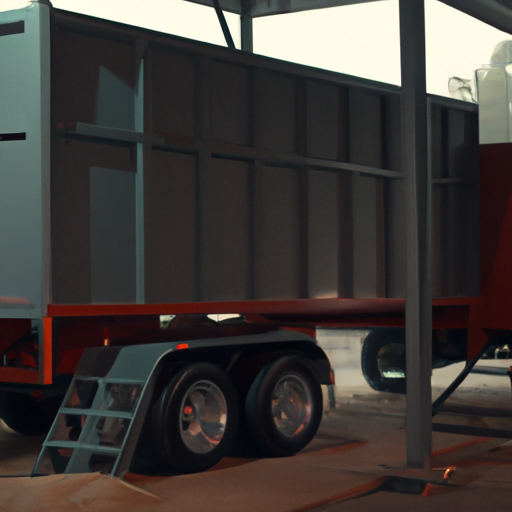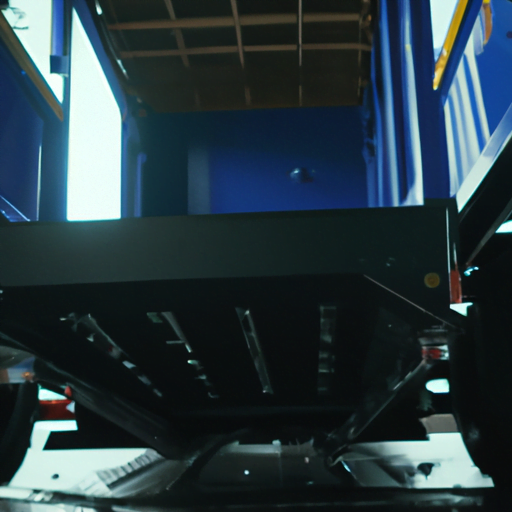-
Table of Contents
Introduction

Heavy Duty Dump Trailers are an indispensable tool in construction and transportation industries. Their manufacturing process is an intricate blend of engineering, technology, and dedicated craftsmanship. The production involves a series of stages from designing the framework to fitting hydraulic systems. This article provides a behind-the-scenes look at how Heavy Duty Dump Trailers are made, unveiling the complexities involved in constructing these robust machines that carry massive loads across long distances with ease and efficiency.
The Manufacturing Process of Heavy Duty Dump Trailers: An In-depth Exploration
Heavy-duty dump trailers are a marvel of modern manufacturing, representing an intricate blend of design ingenuity and industrial might. These robust vehicles form the backbone of construction sites, agricultural projects, mining operations and more. But have you ever wondered what goes into making one? Sit back as we take you on a fascinating journey into the behind-the-scenes world where these mechanical behemoths come to life.
The creation process begins even before any metal is cut or welded – it starts with detailed planning and engineering. Engineers work meticulously to draft blueprints that optimally balance functionality, durability, and cost-effectiveness. With years of experience under their belts – often accompanied by invaluable feedback from end-users regarding previous models’ performance in real-world conditions – they ensure every aspect is perfectly planned out.
Once the blueprint for our heavy-duty dump trailer has been drawn up and approved, production can begin in earnest. The first step involves cutting large sheets of steel according to predefined measurements using high precision laser technology; ensuring accuracy down to the last millimeter.
Next comes fabrication – arguably one of the most essential stages in this entire process. Here skilled welders follow those precise blueprints crafted earlier by engineers transforming raw steel pieces into a recognizable structure: The frame begins taking shape; cross-members are put in place providing structural integrity; sides become discernible followed by tailgate assembly (the ‘dump’ feature); finally axles get mounted onto which wheels will subsequently be attached.
However impressive it looks at this point though remember it’s still just an empty shell without any sort control mechanism rendering its dumping function futile — an issue promptly solved during subsequent stage aptly dubbed installation phase’. This stage witnesses addition key components such hydraulic systems enabling effortless lifting/tilting fully loaded trailer bed strain-free steering equipment reliable braking ensuring safety regardless terrain condition or load weight plus electrical wiring necessary signals lights among other utilities covetable convenience sake user ease operation perspective survival necessity considering stringent transportation regulations particularly those concerning road safety.
Nonetheless, a final touch is vital before our heavy-duty dump trailer can launch onto its mission of hauling and dumping. Like a soldier donning his battle gear, the trailer must be armored against nature’s harsh elements. To achieve this, the surface undergoes careful preparation before being coated with robust paint or powder coating that shields it from corrosion and significantly increases not just its life expectancy but also aesthetic appeal.
Finally, into testing we journey – a rigorous phase where all functional components are put through their paces to ensure they’re in perfect working order. Braking systems get checked for responsiveness; lights for proper functioning; hydraulic systems for seamless operation etcetera ensuring everything indeed meets industry standards even exceeds them because let’s face it value quality always pays off long-term perspective giving customers more bang buck levels satisfaction commitment excellence builds brand reputation ultimately driving future business growth.
So there you have it – an enchanting peek behind curtains at meticulous process that goes into making each every heavy-duty dump trailer stand proudly amid tough terrains take grueling tasks stride proving yet again when skillful engineering combines powerful manufacturing magic happens leading creation something truly remarkable practical yet sublime spectacle watch action!.
Unveiling the Production Techniques for Heavy Duty Dump Trailers
If you’ve ever wondered about the strength and resilience of heavy duty dump trailers, get ready for a fascinating behind-the-scenes look at how these industrial marvels are made. Indeed, advancing technology has brought about exciting changes in production techniques that promote durability and efficiency.
The journey begins with designers who utilize software to draft meticulous blueprints before any physical material is even touched. These designs outline every dimension of the trailer including its length, width and height but also go into greater detail specifying things like axle load distribution and center of gravity positioning.
From there, it’s over to steel procurement where high quality commercial grade steel plates are sourced for construction. It’s no secret that the robustness of these trailers can primarily be attributed to this choice material – sturdy yet malleable enough to be shaped as required.
Once our abundance of steel arrives on site at the manufacturing plant; machine tools such as press brakes bend it following specifications outlined in the blueprints mentioned earlier. This process is typically automated ensuring consistency across units produced while keeping human error occurrence minimal.
Welding is up next where heat fuses pieces together forming a single structure – eliminating gaps between joints thus enhancing sturdiness further still! Spot welding holds components temporarily until more extensive welding takes place which might introduce heat zones causing warping if not controlled properly hence needing experienced hands on deck ensuring all goes smoothly.
Following their formation arc welding routines join parts permanently through electrical currents producing strong bonds able to stand rigors associated with trailer life quite comfortably indeed!
Post-welding brings us cooling operations whereby metal slabs gradually return back down from scorchingly hot temperatures endured during processes such as MIG or TIG joining sessions just moments prior (to touch one immediately afterwards would likely result in painful burns).
Meanwhile on another assembly line sandblasting happens simultaneously preparing surfaces pre-coating by propelling gritty substances against them so paint adheres effectively later once time comes for aesthetic touches.
Then we move towards painting, a key process of not just enhancing the trailer’s appearance but also providing another layer of protection against weather elements. Special paint booths that maintain controlled environments for temperature and humidity ensure the application is even and durable.
Lastly comes inspection where a quality control team comprehensively checks each unit off the production line for any flaws or discrepancies. It’s here where multiple tests are administered to guarantee functionality under different loads and in various conditions – only once passing these with flying colors can a product proudly bear its manufacturer’s name!
And thus, our heavy duty dump trailers stand ready for dispatch – made entirely from scratch following an intricate series of steps combining both human expertise alongside machines diligently putting together tons worth material piece by piece working harmoniously delivering ultimate strength meeting industry needs effectively as ever before! The artistry behind its creation truly is something marvel at when given insight into what goes on beyond factory doors.
Technology advances continue paving way further development within this space promising future creations following similar routes employing refined methods producing units possibly exceeding performance metrics set recently by their predecessors. Regardless how things pan out one thing remains certain though: there will always be need robust dump trailers prompting consistent demand throughout foreseeable future!
From Concept to Reality: The Making of a Heavy-Duty Dump Trailer
It’s no secret that heavy-duty dump trailers are an integral part of our civil engineering, construction, mining, and agricultural industries. But ever wondered how these massive pieces of equipment come to be? It’s a meticulous process turning raw material into a tough piece of machinery designed for enduring the most challenging work environments. Let’s take you behind-the-scenes to appreciate the laborious journey from concept to reality.
The complex manufacturing process begins with thorough planning and design stage where engineers put their heads together. They make decisions about everything – from the size and shape of the trailer all the way down to specifics like axle placement, load capacity, or hydraulic systems needed for off-loading materials. Crucial factors such as intended use, terrain type and weather conditions in operating regions significantly impact this phase.
Once blueprints are finalized using computer-aided design (CAD) software ensuring precision and accuracy; they move onto sourcing raw materials predominantly steel due to its strength & durability. This is where large sheets are cut into patterned shapes suitable for each required piece following which they undergo bending processes via purpose-built machinery.
This leads us straight towards assembly: The heart of this fabrication process! Welding sees forefront here wherein parts start coming together creating skeleton frames firstly including sides making basic frame structure followed by floor installation achieved through sheet metal welding techniques giving structure reinforced stability it demands when hoisting tons upon tons weight
Afterwards comes fitting axles – one defining feature distinguishing regular trailer models from heavy duty ones having multiple axles distributing weight evenly across surface accelerating ability carry heavier loads pass safety inspections without breaking any sweat.
Meanwhile components such as hydraulics system – responsible powering dumping mechanisms – get installed place thus enabling truck raise box deposit contents efficiently quickly possible As if were clockwork every single component builds other resulting powerful unit capable hauling even harshest conditions bravely
Just because we have assembled unit doesn’t mean it’s ready hit road yet An essential locking mechanism integrated keep dump trailer secure transit preventing accidental unloading Lastly, the entire unit gets inspected for safety compliance before it reaches the hands of customers.
It’s in the painting and finishing stage where these workhorses finally get their shine. Well, let’s not forget an anti-rust coating that imparts long-lasting protection against environmental elements. Because when you invest in heavy-duty machinery, you expect nothing less than durability and longevity!
Finally revealed to world stands proud gleaming symbol engineering brilliance materializing from mere concept into reality. It is a testament to human ingenuity and technological advancement that we can mold raw steel into such high-performing equipment ready to withstand rigorous working conditions day after day.
So next time when you see an enormous dump truck driving by or at work at a construction site – Take a moment! Behind every large vehicle like those lie months of preparation & precision-based manufacturing involving complex procedures utilizing advanced technology paired craftsmanship hardworking dedicated individuals who ensure everything goes according plan
As they say: Rome wasn’t built in a day; nor are these massive heavy duty dump trailers! Their meticulous creation process stands witness quality unwavering dedication marks every single step journey marking transition simple blueprint thoughtfully designed robust piece machinery contributing varied industries around globe
Q&A
1. Question: What materials are heavy duty dump trailers made of?
Answer: Heavy-duty dump trailers are primarily made of high-quality steel or aluminum for durability, strength and resistance to corrosion.
2. Question: How is the chassis constructed in a heavy-duty dump trailer?
Answer: The chassis construction begins with cutting and welding strong metal beams together to form the trailer’s framework. It provides stability and support for carrying loads.
3. Question: What process makes the body of a heavy-duty dump trailer?
Answer: The body is typically made by pressing sheets of toughened steel into shape using industrial-grade machinery. Later these components are welded onto the frame, producing a robust structure capable of handling large volumes of material.
Conclusion
Heavy Duty Dump Trailers are a result of a meticulous manufacturing process that involves advanced technology and skilled craftsmakers. The journey starts from the design, followed by cutting and welding high grade steel according to precise measurements. Then, the assembly of components like hydraulic systems or tipping bodies takes place. After thorough quality control checks to ensure durability and optimal functionality, final touches such as paintwork are done hence creating robust equipment ready for heavy-duty tasks in construction sites among others.

